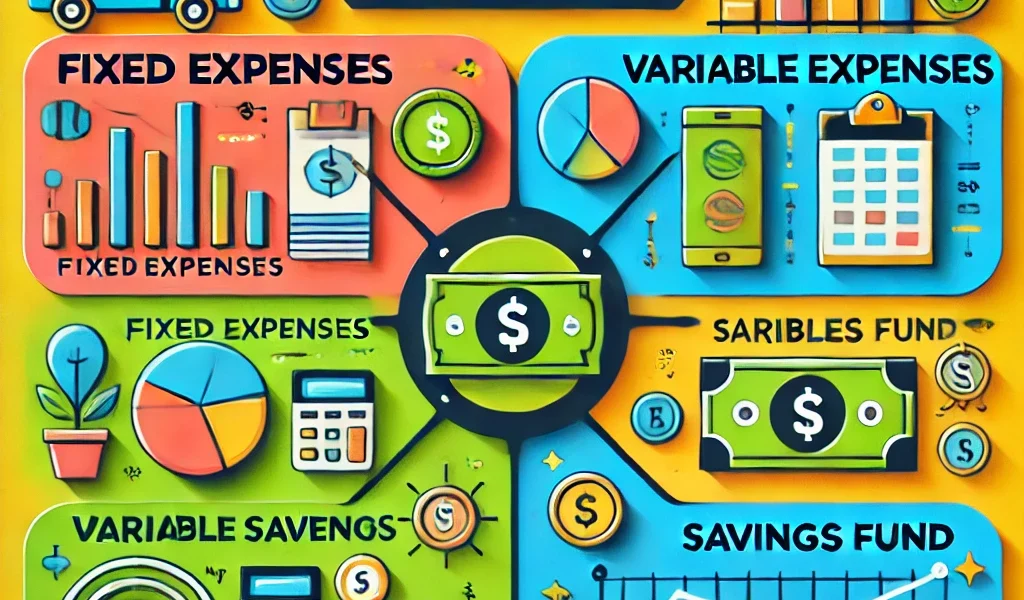📚 Introduction:
Managing your finances with a steady paycheck can be challenging, but budgeting becomes even trickier when your income is unpredictable. Whether you’re a freelancer, a gig worker, or a commission-based professional, irregular income requires a more strategic approach to ensure financial stability. Without a solid budgeting plan, you may find yourself living paycheck to paycheck or struggling during low-income months.
In this guide, we’ll explore practical steps to create a budget with irregular income, safeguard against financial instability, and align your money management with long-term goals.
🎯 Why Budgeting for Irregular Income is Crucial
- Prevents Overspending During High-Income Months
It’s easy to splurge when you have a higher-than-usual income, but without a plan, this can leave you vulnerable during lean periods. - Creates a Safety Net for Low-Income Months
Budgeting helps allocate funds to essential expenses and emergencies when income drops. - Helps Maintain Financial Consistency
Strategic budgeting ensures that basic needs, savings, and investments are covered regardless of income fluctuations.
📊 Step-by-Step Guide to Budgeting with Irregular Income
📝 Step 1: Calculate Your Average Monthly Income
Since your income varies, calculating an average gives you a baseline to work with.
How to Do It:
- Gather data from your income over the past 6-12 months.
- Add all the earnings and divide by the number of months to get the average.
Example:
If your income over the past 6 months is:
₹50,000, ₹65,000, ₹45,000, ₹70,000, ₹55,000, and ₹60,000 —
The average is: (50,000+65,000+45,000+70,000+55,000+60,000)÷6=₹57,500(50,000 + 65,000 + 45,000 + 70,000 + 55,000 + 60,000) ÷ 6 = ₹57,500(50,000+65,000+45,000+70,000+55,000+60,000)÷6=₹57,500
This average becomes your baseline income for budgeting purposes.
📝 Step 2: Identify and Prioritize Fixed and Variable Expenses
Divide your expenses into two categories:
- Fixed Expenses: Rent, mortgage, insurance, utilities, loan payments.
- Variable Expenses: Groceries, dining out, transportation, entertainment.
Pro Tip:
Prioritize essential fixed expenses and allocate funds accordingly before spending on variable expenses.
📝 Step 3: Establish a Bare-Bones Budget
A bare-bones budget covers only the essentials in case of extremely low income. It includes:
- Housing
- Utilities
- Groceries
- Debt payments
- Health and insurance premiums
How to Build It:
- Identify the minimum amount required to cover these essential expenses.
- Allocate this amount as a non-negotiable portion of your income.
📝 Step 4: Create an Income Distribution Plan
Since your income fluctuates, it’s wise to follow a percentage-based approach. A good rule of thumb is:
- 50% for Essentials – Rent, groceries, utilities, healthcare.
- 20% for Savings & Emergency Fund – Secure a safety net for lean months.
- 20% for Irregular or Annual Expenses – Taxes, insurance premiums, vehicle maintenance.
- 10% for Discretionary Spending – Entertainment, dining, and lifestyle expenses.
📝 Step 5: Build a Buffer Fund or Irregular Income Reserve
A buffer fund acts as a cushion for low-income months.
How to Build It:
- Allocate any surplus income to this reserve.
- Aim to build 3-6 months’ worth of essential expenses to ensure financial stability.
📝 Step 6: Set Income Tiers and Adjust Accordingly
Set up income tiers to manage different earning scenarios:
- Tier 1: Below-average income – Stick to a bare-bones budget.
- Tier 2: Average income – Follow a standard budget with fixed percentages.
- Tier 3: Higher-than-average income – Boost savings, pay off debts, and invest extra funds.
📝 Step 7: Automate and Track Expenses
Automation ensures that essential expenses and savings are taken care of without manual intervention.
Best Practices:
- Use budgeting apps to track and categorize expenses.
- Automate bill payments and allocate a fixed amount to savings every month.
💡 Pro Budgeting Strategies for Irregular Income
🎯 1. The 60/40 Rule for Fluctuating Income
- 60% of your income goes to essentials and savings.
- 40% is set aside for variable or discretionary expenses. This helps maintain financial stability while allowing some flexibility.
🎯 2. Use Multiple Bank Accounts for Different Purposes
- Primary Account: For essential expenses.
- Savings Account: For emergency funds and irregular expenses.
- Discretionary Account: For lifestyle and entertainment.
🎯 3. Embrace Zero-Based Budgeting
Assign every rupee of your income a purpose, ensuring that any surplus goes toward savings or investment.
🚨 Common Mistakes to Avoid When Budgeting Irregular Income
- Failing to Account for Taxes – Set aside 20-30% of earnings if you’re self-employed.
- Ignoring Emergency Funds – Irregular income increases the need for a safety net.
- Overspending in High-Income Months – Avoid inflating your lifestyle based on temporary earnings.
📝 How to Review and Adjust Your Budget
Review your budget monthly or quarterly to:
- Identify spending patterns.
- Adjust percentage allocations.
- Reassess goals and make modifications based on income changes.
🎉 Conclusion: Take Control of Your Irregular Income
Budgeting with irregular income may seem daunting, but by following a structured approach, you can ensure stability and safeguard against financial uncertainty. Prioritize essential expenses, build a buffer fund, and adjust your spending based on income fluctuations. With discipline and planning, you can successfully manage your finances and work toward achieving your financial goals.




